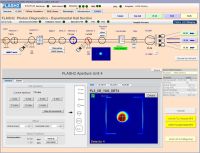Example of the jddd based beamline control (FLASH2)
At FLASH 1 and FLASH2 the photon beam lines, the photon diagnostics as well as the IT infrastructure available for user setups can be monitored and controlled with a dedicated control system. The data collected from the measurement devices (via "DOOCS") can be visualized with a Java based interface (called jddd). Out of thousands of parameters available online, more than 250 essential beamline and diagnostic values are permanently stored in the FLASH Data Acquisition System (DAQ). In addition a User DAQ system records signals provided by user experiments via ADCs, cameras, etc. integrated in the DOOCS infrastructure.
Link to the detailed documentation: CONTROLS and DAQ User manuals
See in particular the documentation for online analysis and control (DOOCSPIE) and for DAQ data analysis (FAB)
Beamline controls:
Photon diagnostics ( monitoring the FEL performance)
- Pulse energy and position (GMD)
- Pulse wavelength (OPIS,VLS)
Beamline control
- Beamline mirror steering
- Gas attenuator, filter wheels, ...
- Beamline cameras, diagnostic screens, alignment lasers …
Experiment related infrastructure
- GHz and MHz ADCs
- Cameras
- Triggers
All DOOCS parameters can be accessed (also pulse synchronized) via Python ( with certain restrictions usage of Matlab / Labview / C are possible as well).
Data Acquisition (DAQ):
The data is saved in HDF5 files (link to the explanation of the FLASH data structure) . To help with the analysis we provide a powerful analysis library
Photon diagnostic DAQ (permanently recording):
- > 250 Parameters are saved
- Electron beam properties ( rep.rate, bunch train length., charge, compression …)
- Photon diagnostic (GMD, spectrum, …)
- Beamline settings (mirror & filter positions , fast shutter status, …)
User DAQ:
- > 20 different options / instruments are available
- GHz ADCs (2/4 Gsample and 100 Msample) provided by FLASH
- User Cameras (~ 20 different types are supported)
- "Gotthard" Detector
- Delayline detectors (provided by users)…
- New hardware can be integrated with sufficient lead time
For further assistance with experiment preparation, questions and further information please contact:
CONTACT DAQ & Controls
|
|||||||
|
|||||||
|
|||||||
|
|||||||
|
|||||||













